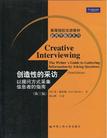创造性的采访
2010-1
中国人民大学
(美)肯·梅茨勒(Ken Metzler) 著
225
傅玉辉 改编
无
One word distinguishes this third edition of Creative Interviewing from the two previous editions: "truth." Or "pursuit of truth," if Im allowed three. In the twenty-five years I have concentrated on journalistic interviewing as a topic of inquiry, Ive become increasingly concerned about truth. What is it? How do you define it? How do you apply it to journalism? Most important, is it en- hanced or impeded by the variety of interview practices common to journalism? What inspired this change? Mostly the fact that the public today sees much more of interviewers in action than ever before. Ever more broadcast shows employ questions and answers. These include acerbic talk shows shouting matches oftentimes. Or you can watch clever people use the Q-A di- alogue to match wits just for laughs. Occasionally you can even watch serious forums for discussion of public events. In all such examples, the public has come to recognize that the nature of the question often dictates the nature of the answer. Jocular questions beget jocular answers. Belligerent questions beget defensive answers. How does truth fare in that arena? How does truth fare under the long standing premise that the work of the journalist is essentiaUy adversarial? The premise suggests that reporters and sources are ene- mies and that the journalistic interview represents a grand chess game of thrust and counterthrust, advance and retreat, win or lose. We may want to rethink those tactics if our journalistic objective is to tell the truth without fear or favor. I like to think of the changes in the third edition as a slight course correction, like a ship captain steering three or four degrees left or right. The changes might seem slight at first, but some of the scenery will be different. Among the changes is an increasing concern for the ethics of the journalistic interview. Its a concern fueled by increasingly prevalent examples, primarily on television, of such shady tactics as the hidden camera sting, the ambush interview, and the screaming meemies, the term I use to cover televisions more boisterous talk shows.
“采、写、编、评”——新闻采访、新闻写作、新闻编辑、新闻评论,是新闻记者的四大基本功,也是新闻传播学专业的四大核心课程。其中的新闻采访则是记者职业技能的重要组成部分,是新闻传播过程的“第一环节”。新闻界素有“七分采访,三分写作”的说法,可见如果没有新闻采访的成果和基础,其后的新闻写作、新闻编辑和新闻评论都将成了无本之木和空中楼阁。 梅茨勒教授曾在美国俄勒冈大学获新闻学学士学位,并有过五年的新闻记者从业经历,早在1972年即开始讲授新闻采访课程。本书是作者在新闻采访的理论知识、实务经验和教学实践成果不断积累的基础之上,历经时间检验所形成的经典性的新闻采访实务教学框架。本书主要介绍了广播电视采访、人物采访、特定领域采访和多重采访项目几大类型,结合实例介绍了采访的具体步骤,并对如何策划采访、创造性地提问、使对话自然延伸、写采访笔记及如何进行采访录音等具体问题提出了细致、独到的建议。
肯·梅茨勒(Ken Metzler),1956年毕业于美国俄勒冈大学,获新闻学学士学位,之后做过五年新闻记者。1961年获美国西北大学新闻学硕士学位,同年开始在该大学任教。现任俄勒冈大学新闻传播学院名誉教授。1972年开始讲授新闻采访课程,曾在世界多个城市主持学术研讨会,讨论新
前言第1章 你采访的问题何在?第2章 何谓采访?第3章 采访的十个步骤第4章 采访要素——个案史第5章 提问第6章 采访中的对话动力学第7章 接受采访第8章 采访设计第9章 失败的教训第10章 学会倾听第11章 新闻观察第12章 引语和轶事的采访第13章 电话采访、采访记录与采访录音第14章 特殊问题第15章 电子辅助采访第16章 广播电视采访第17章 特定新闻领域的采访第18章 多重采访项目第19章 人物采访第20章 采访伦理第21章 通向事实真相的十个步骤附录A 采访练习附录B 采访报告范例参考文献本书所提及的采访
concluding that when words clash with the tone of voice and facial expression, people tend to believe the nonverbal aspects. Eyes That eyes speak volumes is suggested by the folklore on the subject, ranging from language terms ("shifty eyes") to proverbs ("reproof on her lips but a smile in her eyes"). Various studies suggest that eye contact en- hances response and that people tend to look at the other person more while listening than while talking. One study used film clips and asked viewers to evaluate the people who looked at them while speaking cpm- pared with those who seldom looked at them. Viewers judged the look- ers as friendly, self-confident, natural, mature, and sincere. They judged the nonlookers as cold, pessimistic, defensive, evasive, and immature. (Klick 1968.) Kinesics Numerous research studies have suggested that we communicate with our bodies-from a speakers pounding the table to subtle changes in fa- cial expression. The signs do not always contain clear meanings, how- ever. A study once asked people to act out six emotional messages through nonverbal methods. As a video camera rolled, the amateur ac- tors tried to project anger, fear, seductiveness, indifference, happiness, and sadness. When audiences viewing the tapes tried to determine which emotion was which, they usually misperceived four of the six. They perceived one young woman as "seductive" in every one of her six mood transmissions and another woman as "angry" in all six of hers. (Beier 1974.) So much for decoding nonverbal signals. For the interviewer they merely provide hints to be probed for detail. Proxemics Edward T. Hall, an anthropologist, defined four levels of distance be- tween human pairs as they converse in everyday life: intimate, personal, social, and public distances. They range from touching at the intimate distance to about twelve feet and beyond for public distance. (Hall 1966.) The typical interview tends to range from the far side of personal dis- tance (eighteen inches to four feet) to the near side of social distance (four to twelve feet).
运用案例讲解采访技巧 深入探讨采访伦理道德 揭示新闻采访内在规律

无
老师让买的教材而已 无所谓好坏
得学点英语~~
原来是英文版的
可能是峨没看清楚吧、
买回去才发现是英文版、
书的封面标题和导语之类的都是中文、
可内容却全都是英文、
非常具有误导性、
说是双语教材的、
可如果是双语教材不是应该英汉都有么、
总之要看清楚再买吧、
这次就吃个哑巴亏了、
下次、
不、没下次了、
哼、
居然是英文版的,我疯了,虽然有自己的原因,没有看得太认真,但是,书本也实在是具有误导性,封面和目录等都是中文的……唉,算了,权当是激励自己学好英文吧~~